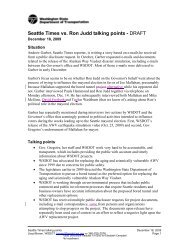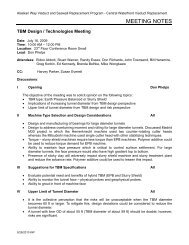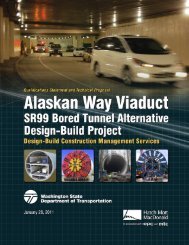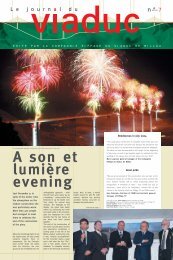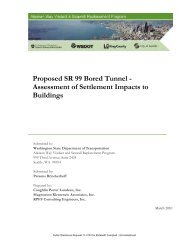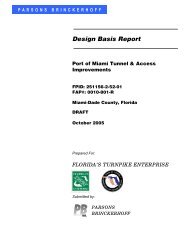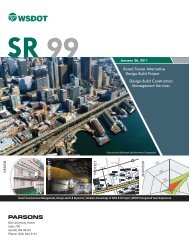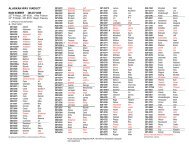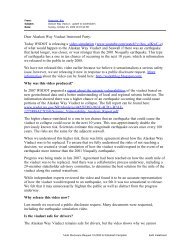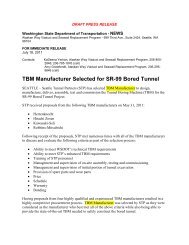Overview of NFPA 502 Standard for Road Tunnels ... - SCATnow
Overview of NFPA 502 Standard for Road Tunnels ... - SCATnow
Overview of NFPA 502 Standard for Road Tunnels ... - SCATnow
- No tags were found...
Create successful ePaper yourself
Turn your PDF publications into a flip-book with our unique Google optimized e-Paper software.
Specifically, Annex E now suggests the consideration<strong>of</strong> fixed fire suppression systems when it canbe shown by engineering analysis that the level <strong>of</strong>safety can be equal or exceeded by their use as part<strong>of</strong> an integrated approach to the management <strong>of</strong> lifesafety. Annex E also addresses, as follows, the previouslylisted concerns which had been expressed bytunnel designers, engineers and worldwide (authorities)regarding the application <strong>of</strong> fixed fire fightingsystem in road tunnels:Concern (1) Typically fires in road tunnelsusually occur inside vehicles or inside passengeror engine compartments designed tobe waterpro<strong>of</strong> from above; there<strong>for</strong>e, fixedfire fighting systems might not have an extinguishingeffect.It is now recognized that the purpose <strong>of</strong> afixed fire fighting fire suppression system is toprevent fire spread to other vehicles so thatthe fire does not grow to a size that cannot beattacked by the fire service.Concern (2) If any delay occurs betweenignition and fixed fire fighting system activation,a thin water spray on a very hot firecould produce large quantities <strong>of</strong> superheatedsteam without material suppressingthe fire.Fire tests have now shown this concern notto be valid. A properly design fixed fire fightingsystem suppresses the fire and cools thetunnel environment. Since a heavy goodsvehicle fire only needs 10 minutes to exceed100 MW and 1200°C, which are fatal conditions,it is important to operate the fire suppressionsystem as soon as possible.Concern (3) <strong>Tunnels</strong> are very long and narrow,<strong>of</strong>ten sloped laterally and longitudinally,vigorously ventilated, and neversubdivided, so heat normally will not belocalized over a fire.Nevertheless advances in fire detection technologyhave now made it possible to pinpointthe location <strong>of</strong> a fire in a tunnel with sufficientaccuracy to operate a zoned fixed firefighting system.Concern (4) Because <strong>of</strong> stratification <strong>of</strong> thehot gas plume along the tunnel ceiling, anumber <strong>of</strong> the activated sprinklers would not,in all probability, be located over the fire. Alarge number <strong>of</strong> the activated sprinklerswould be located away from the fire scene,producing a cooling effect that would tend todraw this stratified layer <strong>of</strong> smoke downtoward the roadway level, thus impeding therescue and fire fighting ef<strong>for</strong>t.Independent laboratories have commentedthat they do not observe smoke stratification.Any activated fixed fire fighting system, notover the fire, would cool the tunnel to helprescue services to intervene. Zoned systemsare released by a detection system that isaccurate even with <strong>for</strong>ced ventilation.Concern (5) Water spraying from the ceiling<strong>of</strong> a subaqueous tunnel could suggest tunnelfailure and induce panic in motorists.This was a theoretical concern not borne outin practice. In the event <strong>of</strong> fire motorists arelikely to recognize water spraying from nozzlesas a fire safety measure. Behavioralstudies have shown that people do not panicin a fire, even when they are unable to see.Concern (6) The use <strong>of</strong> sprinklers couldcause the delamination <strong>of</strong> the smoke layerand induce turbulence and mixing <strong>of</strong> the airand smoke, thus further threatening thesafety <strong>of</strong> persons in the tunnel.This has been shown not to be a valid concern.Fire tests have demonstrated thatsmoke does not usually <strong>for</strong>m a layer at thetop <strong>of</strong> the tunnel but quickly fills the crosssection.Normal air movement in the tunnelaccelerates this process. A fixed fire fightingfire suppression system reduces temperaturesand the risk <strong>of</strong> fire spread to other vehicles.Concern (7) Testing <strong>of</strong> a fixed fire fightingsystem on a periodic basis to determine itsstate <strong>of</strong> readiness could be impractical andcostly. Inspection can be per<strong>for</strong>med whenother facilities are inspected.A full discharge test is normally only per<strong>for</strong>medat system commissioning. Duringroutine testing the system can be configuredto discharge flow to the drainage system.PROTECTION OF STRUCTURE ANDSTRUCTURAL ELEMENTSIn the last edition (2004) <strong>NFPA</strong> <strong>502</strong> introduced newrequirements <strong>for</strong> the protection <strong>of</strong> structural elementswithin road tunnels. The 2008 edition has190




